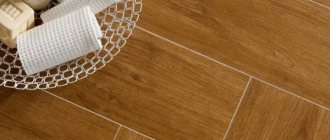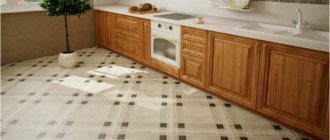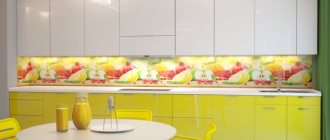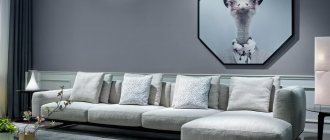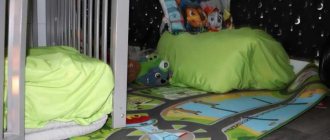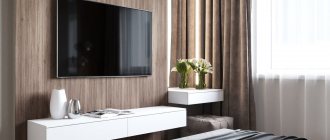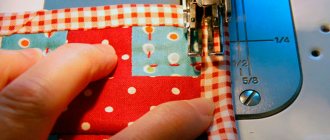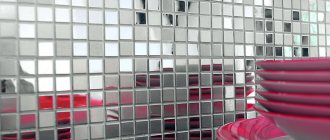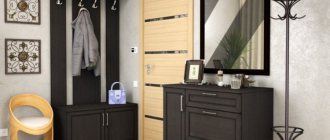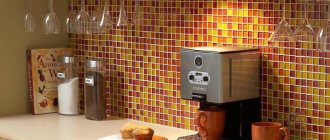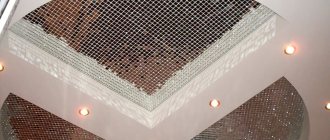Patchwork, or patchwork, is a patchwork sewing technique that has gained great popularity since ancient times, as it made it possible to create voluminous items of an unusual appearance from small scraps of fabric. Large blankets, capes, pillowcases, and bedspreads were sewn using this technique. Nowadays, in order to achieve a patchwork effect, they use not scraps, but textile decor that imitates patchwork. As a rule, interiors in “retro” or “country” style are decorated with this decor.
Modern technologies have made it possible to transfer patchwork patterns to ceramics, and now they decorate not only fabrics, but also walls and floors using patchwork tiles. It has a variety of patterns that are digitally printed and can be either two-color or multi-color.
Patterns are applied to both regular ceramic and porcelain tiles. By combining different patterns, you can achieve an original effect reminiscent of pictures from a kaleidoscope. Quite often you can find specially selected sets on sale - they have the same size and different patterns.
Finishing features
Patchwork style finishing material is created using new technologies. Designs combining patterns of different shades are transferred to blocks using digital printing. Porcelain stoneware or ceramic products are used for cladding.
The slabs are offered by manufacturers as a set or selected for finishing different rooms. With the help of slabs, wall panels and decorative elements are created, floor and wall surfaces are laid out.
A wide range of textures and shades of finishing materials allows the blocks to be used in different style solutions.
To create an original design, you must take into account the rules of combination:
- fragments are laid on the surfaces of the premises according to a single pattern to create a harmonious design;
- parts of the composition must be consistent in the general color scheme and in the same style;
- interior colors should be repeated in tile patterns;
- elements of the placed composition must be of appropriate thickness and suitable dimensions;
- The technique of applying the image and the processing of the edge must be the same;
The design of patchwork blocks should complement the layout of the room.
Don't forget about the little things
Even if you decorate your kitchen with a huge wicker panel covering an entire wall, the true manifestation of the patchwork style is reflected in the small details.
Think about what items you would like to place additional emphasis on: they should resonate with the main element, as if emphasizing and shading it.
Don’t be afraid to use handmade ones - it will add uniqueness to the room, which is so valued by lovers of this technology.
What can we say in conclusion? Patchwork is a unique stylistic addition that will help create an atmosphere of warmth and comfort in the kitchen. But you need to be very careful with it - no overdoing it, otherwise the effect will be exactly the opposite.
Personally, we would recommend it to those who like bright things “with history.” But for lovers of more classic interiors, we advise you to look at the special section of our website.
Ceramic tiles in patchwork style: art in the interior
Patchwork tiles for the bathroom are designed to create an original design of walls, floors, and accent inserts in the interior. When decorating panels with decorative elements with patterns, designers recommend choosing furniture, accessories, and textiles that are monochromatic and restrained in color.
In the background finish for slabs, the optimal basic color palette is:
- beige;
- light gray;
- white;
- blue;
- olive.
An original tile finish on the surface of the bathroom floor with monochrome walls in light colors or a wall in the shower with a composition of slabs with patterns.
An artistic panel made from patchwork blocks can become an accent part of the bathroom interior.
When decorating the floor surface, it is possible to lay “patchwork rugs” on the floor to outline functional areas next to the shower stall, at the sink, or at the entrance to a spacious room.
Compositions of ornaments are emphasized by slabs with smooth matte or glossy surfaces.
Kitchen-living room (photo)
A kitchen combined with a living room implies an identical stylistic solution in both functional areas. Patchwork on the kitchen floor will stylishly emphasize the panel in the living room above the sofa made of the same tiles. Another option for a “carpet” is the area opposite the sofa, where the TV is located. This will decorate and zone the space of the room.
Tile combinations
When composing combinations of elements, it is necessary to select slabs with similar parameters based on the type of edge, thickness, and technique for processing the external surface. It is important to maintain the combination in geometry and shade range.
It is optimal to use slabs with monochrome patterns, combining 2-3 shades.
Manufacturers offer ready-made collections of blocks with combinations of elements of different patterns and sizes, designed in a single color scheme.
When selecting individual elements, it is necessary to take into account the match in style, color or geometry.
Small or large fragments
When choosing the sizes of decorative slabs, it is necessary to take into account the dimensions of the room for finishing. In small bathrooms, it is optimal to use compact blocks - 10x10, 20x20 cm.
When using large slabs, the compact space will visually narrow. In rooms from 6 m² you can use medium-sized slabs.
In spacious bathrooms in private homes, you can decorate with large-format decorative elements simulating several small patterned slabs.
Apron
The backsplash is the first and foremost place to use Patchwork to add personality to your kitchen. It plays not so much an aesthetic, but primarily a practical role in the kitchen, keeping the work area clean.
Patch tiles essentially give you creative freedom and add color and pattern to a room in abundance, but you don't have to be limited to just the traditional design approach of using the standard 5-6 patterns.
Any style will do, from eclectic to sophisticated, from monochrome to a stunning Mediterranean that has irrepressible vitality. Each composition should be full of uniqueness, expressiveness and intrigue.
Rustic style
Stylistic compositions
Boards with designer finishes and multi-color combinations are suitable for different styles.
However, it is important to select the appropriate color scheme of elements and type of patterns.
The products are widely used in the following areas:
- country;
- Provence;
- classic;
- minimalism;
- Scandinavian;
- retro, etc.
Minimalist interiors are decorated with patchwork blocks in neutral colors (light gray, beige) and a combination of pastel colors. Ceramic blocks with graphic patterns will allow you to create accent areas and visually expand the room.
The main decoration of the interior will be the patterns on the blocks. The elements are arranged randomly or using collage techniques.
It is necessary to match the color scheme of the walls, floors and patchwork slab inserts.
Organically bright slabs look great in a country style interior. When finishing, monochrome combinations of rich tones (brick, terracotta, orange, green) or with patterns of different shades are used.
It is necessary to create smooth transitions of multi-color and neutral colors in the decoration of the room.
Ceramic products using the patchwork technique are common in the decoration of premises in the Provencal style. The room will be decorated with slabs in pastel colors with floral or graphic patterns; it is possible to include stripes on the blocks.
For the style direction, slabs with the effect of brushing, aging of the surface, and imitation of decoupage on blocks are organic.
Retro-style rooms are complemented by multi-colored slabs in bright colors. Warm rich shades (burgundy and beige, brown and green) are optimal. It is necessary to complement the surface with slabs with the effects of scuffs, chips, or patterns that have faded over time.
The elements will allow you to recreate an imitation of the historical interior setting using ornaments from different eras.
In a classic room, tiles with geometric patterns can be used. The color scheme should be neutral (blue, white, dark brown, white, light gray, sand).
Combinations of dark gray and muted green, golden and milky are popular. The elements can use a cage or strip.
Mediterranean-style spaces use patchwork blocks with a combination of white and navy blue. Combinations will visually expand the room and create an original accent on wall panels and floor surfaces. Light green, milky, and light yellow shades look harmonious in a Mediterranean interior.
Patchwork slabs can be decorated with thin stripes, checkered patterns, and geometric patterns on a light background.
In Scandinavian interiors, it is optimal to use products in light colors with geometric patterns; it is possible to include colored elements against a background of beige and milky shades.
Decorative slabs can be combined with solid wood elements or complemented with wood furniture.
Styling tips
Patchwork allows you to combine different textures into one whole, that is, you can combine glossy tiles with matte ones, imitation of natural texture (wood, stone) with patterned fragments. A glossy surface is more suitable for a kitchen backsplash and is easier to keep clean. Matte tiles are safer on the floor; they reduce the risk of accidentally slipping on a wet surface.
Patchwork tiles with a raised pattern look very attractive, but they are not very practical for the kitchen. It is difficult to care for, as dust and dirt get stuck in the recesses. Also, you should not choose patchwork fragments with a mother-of-pearl or metallized coating for your kitchen apron. As a rule, such tiles do not tolerate aggressive detergents well.
You can lay out the tiles randomly or in a certain order, repeating the pattern. The easiest way is traditional laying in squares, but combinations of rhombuses or tiles with a figured edge are also possible.
The following combinations of patterns are found in ready-made tile sets:
- floral ornament with rounded smooth lines and sharp geometric patterns;
- smooth tiles without a pattern alternate with ornamented fragments;
- Some tiles have a small and faint meaningful design.
The brighter and more contrasting the pattern, the more difficult it is to fit it harmoniously into the interior. Nowadays, combinations of white with blue, beige, and gray are especially popular. This is a fairly calm combination. It will not create uncontrollable chaos and an “explosion of color.”
Important! The smaller the kitchen, the smaller the size of the patchwork tiles should be. Lay tiles with a side of 10-15 cm on the apron. For the floor you can take 20-25 cm or more. But do not forget that too large fragments visually make the kitchen smaller.
Wall tiles
Elements using the patchwork technique are used to decorate wall panels. The slabs are lightweight for easy installation. The products are not designed for heavy loads, are decorative, and are available in different textures.
Wall elements are placed to accentuate the shower area, at the sink, or as a horizontal strip above the bathtub.
Surfaces must be resistant to humidity, frequent cleaning, and chemicals.
Floor mosaic
Patchwork mosaic for the floor must be wear-resistant, designed for heavy loads, and resistant to chemical detergents. The color range of products is standard and must correspond to the uniform style of decoration of the room.
For long-term operation, it is important to consider the thickness and dimensions. Floor elements are available in large sizes for easy installation.
It is necessary to take into account the low thermal conductivity of coatings and install a “warm floor” system.
When selecting materials for floor finishing, experts advise choosing durable porcelain stoneware blocks. The products are evenly tinted and more durable under constant mechanical stress.
In ceramic products, paint is applied to the surface; the slab is not painted in bulk and loses color intensity over time. Porcelain stoneware blocks are distinguished by their heavy weight and resistance to damage under loads.
You can tile the entire floor surface in the bathroom or create a long strip at the edge. The creation of accent inserts at the sink or shower with imitation carpet looks original.
How to choose a color
Competent kitchen design involves creating a background in which bright areas will harmoniously combine with plain ones. For example, a kitchen apron can be made in soothing autumn colors. And to give the interior consistency, you can add to it a kitchen set with a lot of artificial scuffs.
The kitchen walls in the apron area can be beige or milky, in the color of natural linen or burlap. Patchwork in postmodern style is the most modern option for kitchen design. In this solution, black and white tones predominate, and the patchwork pattern is replaced by tiles in geometric patterns.
Patchwork tile manufacturers
Manufacturers of ceramic and porcelain tiles include products using the patchwork technique in their collections. Ready-made sets of blocks are offered, differing in size or design. For flooring, large blocks of porcelain stoneware are offered with an imitation layout of 4-8 mosaic patchwork elements.
The products market includes products from Italian manufacturers (Ragno Marazzi, BayKer), Spanish materials from the La Platera, Roca, Mainzu brands.
The following companies are also included in the ranking of popular products:
- Cersanit (Poland);
- Kerama Marazzi (Russia);
- Lasselsberger Ceramics (Austria).
Products from domestic manufacturer Kerama Marazzi
It is distinguished by its affordable price, versatility, and the presence of a wide range of sizes and shades of slabs for various purposes. Products are manufactured in accordance with European standards.
In addition to ceramic blocks, the manufacturer’s product line includes high-quality porcelain stoneware products.
Italian company Italion
Produces decorative tiles, porcelain stoneware blocks for finishing bathrooms and showers. The company develops finishing materials for walls and floors and offers a wide range of patchwork bathroom tiles.
The products are of high quality, with a rich palette of colors and patterns.
Polish company Cersanit
It produces complex products for finishing bathrooms. The company offers collections of patchwork products, for which you can select finishing materials taking into account style and workmanship.
The products are high quality, wear-resistant, durable.
Dual Gres Company
Supplies porcelain slabs with elegant designs in different styles. The products are strong, durable and high quality.
Products are manufactured in accordance with European standards and undergo quality testing.
Patchwork ceramics for the kitchen
This material is an integral part of the kitchen and can become a key part of its design. Patchwork offers something completely different than any other style of pottery. Creative shapes, sophisticated designs attract attention and instantly make a feature wherever they are used. It works equally well in a modern or traditional setting.
Whether the purpose is to add color, texture or simply to make a room water-resistant, patchwork is used to add a unique touch to any scheme, as it often contains ethnic or retro combinations. They perfectly set the tone and dynamics of a kitchen scheme.
Stylish kitchen in dark colors
Patchwork is versatile enough to be used on floors or walls. Another reason why this style has become so popular is that it adds a designer look that looks more expensive, but at the same time, patchwork can be just as cost-effective as other tiles.
Origin story
Its rich history also contributes to its charm and mystery. The image of patterned tiles originated in the Mediterranean countries - Spain, Portugal, Morocco, Italy, Greece. This cultural background has led to this design being also known as Spanish tile, Moroccan tile, wicker tile, bohemian tile (boho tile), or even DIY.
The modern version of the tiles on the market are inspired from around the Mediterranean. Thanks to the combination of decorative patterns, geometric patterns, faded motifs, it is suitable for giving life to walls or floors.
Black and white colors for the room
Photo gallery of patchwork style tiles
To decorate a bathroom and toilet with slabs with graphic patterns, the following are used:
- inserts;
- interior accents.
Inclusions of decorative elements are used in the decoration of floors and walls. It is important to take into account the color scheme of the room; the most effective use of slabs with patterns on a monochrome surface.
Elements included in a monochromatic masonry may differ in dimensions and patterns, while maintaining the same style and color.
Insertions are made using plates:
- plain with pattern;
- monochrome with ornaments in different techniques;
- multicolor;
- multi-colored slabs with combinations of lines and patterns.
Interior accents serve to visually highlight a piece of furniture (table, sink) or part of a continuous surface.
Experts suggest tiling part of the bathroom, the walls of the shower stall, the space above the sink or the surface of the table.
A narrow line with blocks of floral or graphic patterns will visually lengthen the space of a small bathroom.
Accent areas can be the surfaces of arches and columns in a spacious bathroom.
An original interior accent is the placement of carpet-shaped blocks in the center of the room, simulating suitable techniques (“checkerboard”, “diagonal”).
Plates with aged effects and muted shades look original in different types of interiors.
Products with the effects of brushing and decoupage of surfaces look stylish in rooms complemented with forged interior items (bookcases, chairs, stands) and furniture made of natural wood.
Examples in the interior
DO YOU HAVE ANY QUESTIONS?
Ask a specialist
